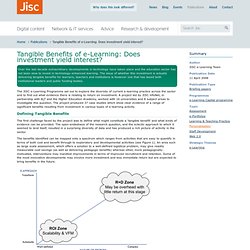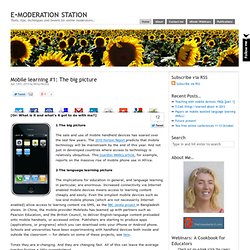

This New Method Could Have Us Learn Languages a Lot Faster. Tangible Benefits of e-Learning: Does investment yield interest? Over the last decade extraordinary developments in technology have taken place and the education sector has not been slow to invest in technology-enhanced learning.

The issue of whether this investment is actually delivering tangible benefits for learners, teachers and institutions is however one that has taxed both institutional leaders and public funding bodies. The JISC e-Learning Programme set out to explore the diversity of current e-learning practice across the sector and to find out what evidence there is relating to return on investment. A project led by JISC infoNet, in partnership with ALT and the Higher Education Academy, worked with 16 universities and 8 subject areas to investigate this question. The project produced 37 case studies which show clear evidence of a range of significant benefits resulting from investment in various types of e-learning activity. Defining Tangible Benefits Fig. 1 Cost Savings/Resource Efficiency. CAMEL Tangible Benefits of e-Learning. See the final report1 and case study template1 the project developed The CAMEL Tangible Benefits of e-Learning Project aimed to collate and share the tangible and real benefits to staff, learners and institutions of e-learning, through a discipline and academic department focus by using the CAMEL model devised by JISC infoNet and ALT.

Its objectives were to produce: up to 16 institutional case studies, with a subject discipline focus, to identify tangible benefits of e-learning; and report on the CAMEL workshops and evaluation of the process (also identifying any real or perceived weaknesses or threats of e-learning). The final outputs are 37 case studies from 16 institutions, so the project has exceeded its original case study target. Approach Outputs The case studies, incorporating a rich selection of media including graphics, video and simulation games, were developed on a password-protected wiki.
Mobile learning. John Dewey, writing in the early years of the twentieth century, may not have foreseen the proliferation of 21st century ‘mobile devices’ but, in the quotation to the right, he does point out something that remains relevant: that mobile learning involves change, initiative and adaptability.

Mobile learning involves change in the sense that the ability to communicate with tutors and peers, as well as access learning resources, changes what is possible in education. It takes initiative for leaders to create a vision to sustain that change and, finally, mobile learning requires adaptability by members of staff to carry out the change. What is m-learning? Hot off the press, we are pleased to present the Mobile Learning infoKit.

Launched at ALT-C 2011 The infoKit offers valuable advice for any organisation starting out in m-learning, as was compiled with interviews and contributions from all the main thinkers, creators and educators in this space See the overview presentation (below) for a great introduction to m-learning, and if you want more you can download the entire infoKit at Many months in development, this infokit was put together by Doug and those nice people at Jisc infoNet as a service to the education community. Thanks all! Definition of mobile learning Over the past 5 years there have been wide ranging debates about how to define, precisely, what mobile learning is. Our current best definition comes from the eLearning Guild who defined it as: Mobile ESL. Mobile learning #1: The big picture. [Or: What is it and what's it got to do with me?]

1 The big picture The sale and use of mobile handheld devices has soared over the last few years. The 2010 Horizon Report predicts that mobile technology will be mainstream by the end of this year. And not just in developed countries where access to technology is relatively ubiquitous. This Guardian Weekly article, for example, reports on the massive rise of mobile phone use in Africa.
Podcast sites. Using Blogs and Voki to increase motivation and oral participation a… Voicethread, Voki, Listen & Watch: English Homework for Listening and Speaking. Does the Internet Make You Smarter? - WSJ. Does the Internet Make You Dumber? - WSJ. Continuous Partial Attention. What is continuous partial attention?

Continuous partial attention describes how many of us use our attention today. It is different from multi-tasking. The two are differentiated by the impulse that motivates them. When we multi-task, we are motivated by a desire to be more productive and more efficient. We’re often doing things that are automatic, that require very little cognitive processing. To pay continuous partial attention is to pay partial attention — CONTINUOUSLY. We pay continuous partial attention in an effort NOT TO MISS ANYTHING. Is continuous partial attention a good thing or a bad thing?
Like so many things, in small doses, continuous partial attention can be a very functional behavior. Is this theory U.S. centric? In my research to date, most of the examples and time frames are U.S. centric. How does this play out with different generations? The younger generations are on the leading edge of thought for the coming dominant attention paradigm. What do we do about it? Russell Stannard "Simple ICT Tools"
Oro.open.ac.uk/11617/1/S0958344008000335a.pdf. Module #3 - Becoming a Google Drive Master. From Computer Assisted Language Learning (CALL) to Mobile Assisted Language Use (MALU) Huw Jarvis University of Salford, UK <h.a.jarvis salford.ac.uk> Marianna Achilleos Freelance EFL tutor, Cyprus <dorantello hotmail.com> Abstract This article begins by critiquing the long-established acronym CALL (Computer Assisted Language Learning).

Introduction The term Computer Assisted Language Learning (CALL) became established in language education in the early 1980s (Chapelle, 2001). In this article, we begin by defining and critiquing CALL. A critique of CALL A number of scholars have provided us with now well-established definitions. We have in recent years seen a recognition of OMDs such as smartphones and eBook readers, such as Amazon.com’s Kindle. 2_1_Wang.pdf. 48_3_4_reinders.pdf. Mobile assisted language use.